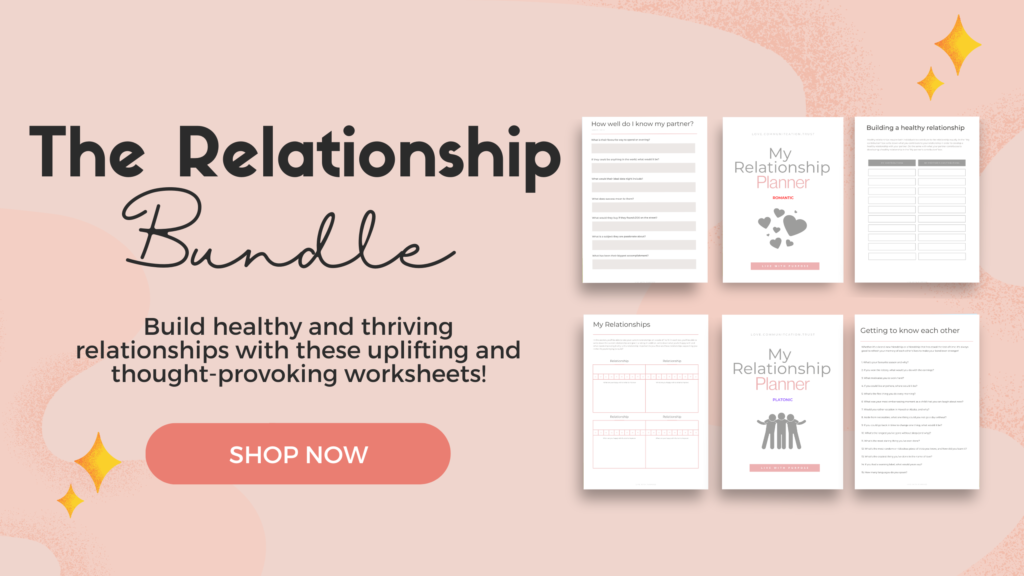
In a world that often emphasises the value of social connections, there’s an important distinction to be made between being alone and feeling lonely.
Many people associate solitude with a sense of isolation or sadness, but the truth is that being alone can be a fulfilling and rejuvenating experience. 😊
In this blog post, I will explore the nuances of being alone versus feeling lonely, understanding the importance of solitude, and embracing the positive aspects of both states.
Let’s get to it. 💕
The Difference Between Being Alone and Feeling Lonely:
Being Alone:
Being alone is a state of physical solitude, where you find yourself without the company of others. It can occur by choice or as a natural consequence of circumstances. Spending time alone provides an opportunity for self-reflection, relaxation, and personal growth.
It allows you to engage in activities that bring you joy, pursue hobbies, or simply enjoy a moment of peace. Being alone can be a deliberate choice, a time to recharge and connect with oneself. 🥰
Feeling Lonely:
Loneliness, on the other hand, is an emotional state that arises from a perceived lack of meaningful connections. It’s possible to feel lonely even in a crowded room if the connections are superficial or unfulfilling.
Loneliness is often characterised by a sense of emptiness, isolation, or a longing for deeper human connections. It’s a complex emotional experience that can impact mental and physical well-being. 😟

Embracing the Positive Aspects of Being Alone:
1. Self-Discovery:
Being alone provides an opportunity for self-discovery. It allows you to explore your thoughts, feelings, and interests without external influences. Use this time to reflect on your goals, values, and aspirations. Self-discovery is a crucial aspect of personal growth and can lead to a deeper understanding of oneself.
2. Independence:
Embracing solitude fosters independence. When you’re comfortable being alone, you become more self-reliant and less reliant on others for your happiness. This independence can empower you to make decisions based on your own needs and preferences, leading to a more authentic and fulfilling life. 🥰
3. Creativity:
Solitude often sparks creativity. When you’re alone with your thoughts, you have the mental space to generate new ideas, think critically, and engage in creative pursuits (yaay). Many artists, writers, and innovators find inspiration in moments of solitude, leading to the creation of meaningful and impactful work. 🎨
4. Rest and Rejuvenation:
Being alone allows for rest and rejuvenation. In a world filled with constant stimuli, taking time for solitude can be a form of self-care. It provides an opportunity to relax, recharge, and focus on activities that bring you peace and joy, contributing to overall well-being.

Addressing the Challenges of Feeling Lonely:
1. Cultivating Meaningful Connections:
If loneliness arises from a lack of meaningful connections, focus on cultivating relationships that nourish your soul. Seek out individuals who share your values and interests. Join clubs, organisations, or communities where you can meet like-minded people. Focus on getting yourself out there. Quality connections are often more fulfilling than a large social circle. 🫂
2. Volunteering and Giving Back:
Engaging in volunteer work or contributing to your community can alleviate feelings of loneliness. By helping others, you not only make a positive impact on the world but also connect with individuals who share a common purpose. Volunteering provides a sense of belonging and fulfillment.
3. Seeking Professional Support:
If loneliness becomes a persistent and overwhelming emotion, maybe consider seeking professional support. A therapist or counselor can provide guidance and a safe space to explore the root causes of loneliness. Addressing these issues with professional help can lead to a more fulfilling and connected life. 🫶
Finding Balance:
The key to a fulfilling life lies in finding a balance between being alone and fostering meaningful connections. Embrace solitude as a time for self-discovery, creativity, and rejuvenation. At the same time, actively cultivate relationships that bring joy and fulfillment. Recognise that both states are essential for a well-rounded and satisfying life. 💕
Conclusion
Being alone and feeling lonely are two distinct experiences, each with its own set of opportunities and challenges. Embracing solitude allows for self-discovery, independence, creativity, and rest. However, if loneliness creeps in, it’s crucial to address it by cultivating meaningful connections, volunteering, or seeking professional support. You are not alone. ❤️
Understanding the nuances between being alone and feeling lonely empowers you to navigate both states with intention and purpose. Ultimately, finding a balance between solitude and social connections contributes to a rich and fulfilling life. Embrace the positive aspects of being alone, foster meaningful connections, and savor the journey of self-discovery in this beautiful dance between solitude and companionship.
Pin this post for a reminder 📌 👇

Related Blogs
Things to Say “No” to for you to Live a Happier Life
How to Stop Settling For Less Than You Deserve
How to Become the Best Version of Yourself: A Guide For 20-Somethings
“Gratefulness is the key to a happy life that we hold in our hands, because if we’re not grateful, then no matter how much we have we will not be happy- because we will always want to have something else or something more”.
Br. David Steindl-Rast
It’s no secret that practicing gratitude is good for you. Those who have a more grateful personality are in a better position to find satisfaction in life. 🧘
We all have the ability and opportunity to cultivate gratitude. Rather than complaining about the things you wish you had, reflect on the things you do have.
Quick exercise: Look around you right now and write down/mentally note three things that you can see that you’re grateful for. Whether it’s your sister annoying you from the other side of the room or the comfy bed you’re laying in with your hot water bottle. 🥰
I would say that I’m pretty good in regards to practicing gratitude, but I’m becoming a lot better by seeing and feeling the benefits it has. I usually take for granted the legs that I have to walk on, the food I eat every day or the roof over my head. It’s good to remind yourself of all your blessings.

The other day I filled up a jug of water to put in my car for with windscreen wipers and while I was carrying this heavy jug of water, I stopped to think about all the people in developing countries who would give anything just to take a sip of what I was carrying to put in an inanimate object and it made me feel even more grateful for the life that I have. 🥲
“Change your attitude, change your life”
Savouring your positive experiences makes them stick in your brain and increases their benefits to your psyche – and the key is expressing gratitude for the experience. That’s one of the ways gratitude and appreciation go hand in hand. – Psychologist Fred Bryant.
Showing gratitude is not merely saying “thank you” when you receive something, we all do that (well we should) but there’s so much more to it.
Let’s graduate from basic to advanced gratitude. It’s easy to feel grateful when great things happen, but no-one feels grateful when they find out they didn’t get the job they wanted or the house they wanted. Usually in these moments feeling grateful for anything flies out the window. Rightly so, but guess what? 🤔
Even in these low moments, there can still be positive outcomes. 🙂

Maybe you didn’t get the job you wanted because there’s a closer, more stimulating and higher paying job waiting for you, or you didn’t get the house you wanted because your dream home you don’t know about yet is about to go on sale. 🏡
Never lose hope.
Daily gratitude habits can help you connect with your sense of inner peace, especially when you need it most. It improves our health and mental well-being, affecting our career and relationships.
Here are a few ways you can start to practice gratitude:
Start a gratitude journal
Choose a time in the day where you have 5-10 minutes to yourself for reflection, whether it’s the first thing you do in the morning, during lunchtime or just before you’re about to go to bed.
Coendure up 3-5 things each day you are currently grateful for. From the small things (the expensive lipstick you’ve always wanted has gone on sale/ your favourite flowers are in bloom) to the exceptional (Finding the love of your life/witnessing your child’s first steps). 👣
You can choose any notebook but preferably a notebook that stands out to you, as this is a journal you should plan to keep for a very long time so that your future self can thank you for it.
Imagine yourself 5 years from now having kept your journal all that time. How different do you think you’ll be? Do you think you’ll be more positive? Feel less stressed? More enthusiastic about life in general?
OF COURSE!
Take the first steps towards that “future you” today by starting your gratitude journal.
Express in person
Expressing gratitude in person can be extremely effective. Whether it’s face-to-face, over the phone or even through Facetime. Let someone know in detail the impact that they have created in your life.
Your bond will become stronger as the dynamic in your relationship changes and create a long-lasting friendship or partnership.
It’s often the simplest gesture that speak volumes in showing your gratitude. We all have amazing people in our lives who inspire us and generally make life better by being in it.
It’s time to let them know that before it’s too late. ❤️

Live mindfully
Living mindfully requires patience and dedication. It also requires you to break out of old habits and patterned behaviours that make us focus on things we cannot change.
Consciously throughout the day take the time to pay attention to your surroundings and the details of your environment that you take for granted.
Notice the colour of the flowers you walk by every morning or the shape of the leaves that crunch under your feet (Who doesn’t love the sound of a crunchy leaf? 🍂). When you notice the small details of your surroundings, ask yourself questions about why these things are the way they are and not any different.
These questions will allow you to draw deeper into the moment and will help you develop a habit of mindfulness.
RELATED: Want to learn more about mindfulness? Check out me eBook here! >> The keys to self-mastery
Focus on intentions
When you receive a gift or someone has done something nice for you, consider the fact that someone willingly chose to bring positivity into your life even at a cost to themselves. 🎁
Acknowledging other’s thoughtfulness towards you goes a long way toward cultivating an attitude of gratitude.
Being consciously aware of your present moment will help you gain better insights into other people’s behaviour, intentions and motives.
Even if you don’t 100% know whether someone’s intentions are good or bad, it’s always good to assume positive intent.
When we choose to believe positive intent, we find ourselves having better relationships, higher quality communication, stronger bonds of trust and the opportunities for growth are exponential.

What’s your favourite way to practice gratitude?
To summarise, the simple act of expressing gratitude can and will change your life in several different ways. Start your journey towards gratitude enlightenment by jotting down what you’re grateful for and find productive ways to express it using the tips listed in this post.
When was the last time you expressed gratitude and who was it to? Let me know in the comments section!
Pin this post for a reminder 📌 👇

Related Blogs
How to raise your standards and live your best life
Did you know that people on my email list sometimes get exclusive discounts on my products? Join the community and save yourself some coins!
Freshly-squeezed inspiration, and no-nonsense tips + tricks to improve your life delivered to your inbox weekly.
Subscribe to my newsletter
Subscribe
You're all signed up!
Be sure to whitelist our email address so that all the goodies make it to your inbox.
